2. 中国科学院研究生院, 北京 100049
2. Graduate School of Chinese Academy of Sciences, Beijing 100049, China
三江特提斯成矿带是我国新生代构造活动强烈、成矿作用发育的地区之一(王登红等,2002;Hou et al., 2007),云南澜沧老厂铅锌多金属矿床是该成矿带南段重要的大型铅锌多金属矿床,以开采历史悠久和富银(铅锌矿石中平均含量为629.46×10-6,方铅矿中平均2069.07×10-6)、伴生元素多(In、Te、Ga、Cd、Bi) 且规模大(In、Cd、Se、Te已达大型规模)、含Sn等特征而为广大地质学家所关注,开展了较详细的地层学(如丁林和钟大赉,1995;周玉华等,2007;等)、岩石地球化学(如叶庆同等,1992;莫宣学等,1993;刘友梅和杨蔚华,2001;龙汉生,2009;等)、矿床地质(如李虎杰,1990;杨开辉和莫宣学,1993a,b;李雷等,1996;陈松岭等,1997;魏冠军,2005;王新利等,2006;张准等,2006;李潇雨等,2007;李光斗,2010;等) 和成岩成矿年代学(如彭寿增,1984;冯庆来和刘本培,1993;欧阳成甫和徐楚明,1993;陈元琰,1995;陈百友,2002;龙汉生,2009;陈觅,2010;等) 等研究,为认识本矿床成矿作用积累了大量宝贵地质地球化学资料,然而目前对于本矿床的成矿机理仍然存在较大分歧和争议,包括有以下三种成因观点:(1) 火山喷流沉积成因(杨开辉等,1992;龙汉生等,2007);(2) 岩浆热液成因(徐楚明和欧阳成甫,1991;欧阳成甫和徐楚明,1993;李虎杰等,1995;薛步高,1998);(3) 火山喷流沉积+后期岩浆热液叠加成因(李雷等,1996;王增润等,1997;陈百友等,2000)。此外,随着近年来深部新生代巨厚斑岩型Mo (Cu) 矿体的发现,矿区深部隐伏喜山期花岗斑岩对铅锌矿化作用的影响程度更需要得到正确认识(李峰等,2009)。
闪锌矿是铅锌矿床中最主要矿石矿物之一,常含有Fe、Mn、Cd、Ga、Ge、In、Se、Te等多种微量元素,且这些元素蕴含着众多成因信息(刘英俊等,1984;涂光炽等,2003),长期以来众多学者试图通过总结其微量元素组成特征来划分矿床成因类型或提供有用成矿信息(刘英俊等,1984;Zhang, 1987;韩照信,1994;Huston et al., 1995;Beaudoin, 2000;涂光炽等,2003;Di Benedetto et al., 2005;Ishihara et al., 2006;Martín and Gil, 2005;Monteiro et al., 2006;Gottesmann and Kampe, 2007;Ishihara and Endo, 2007;Wang et al., 2010),但由于“分析测试方法差异及精度”和“有用微量元素选取不同”等使这方面研究实用性不强,近年来,随着LA-ICPMS等高精度仪器的出现,原位测试硫化物微量元素组成成为可能,一些学者开始采用这种测试方法研究不同类型矿床闪锌矿微量元素组成特征,并取得了很好成效,为正确认识微量元素在不同类型闪锌矿中分布特征开辟了新的途径(如Cook et al., 2009,2011a,b)。本研究通过LA-ICPMS和ICP-MS对矿床中闪锌矿微量元素组成进行对比研究,结合矿床地质特征,以探讨矿区铅锌成矿作用,为甄别已有成因观点提供实际证据。
1 区域及矿床地质简介云南澜沧老厂大型铅锌多金属矿床位于三江成矿带南段之昌宁-孟连裂谷次级澜沧断陷盆地中,其大地构造背景位于兰坪-思茅盆地与临沧地块西缘,保山-掸邦微陆块东缘,属于东特提斯构造域,是冈瓦纳古陆与欧亚大陆巨型缝合带的组成部分。矿区地层出露以泥盆系、石炭系、二叠系及第四系地层为主,石炭系地层是矿区铅锌多金属矿体的主赋矿层位,其下统为火山-沉积岩建造(包括安山质、粗面质、玄武安山质、玄武质凝灰岩、角砾岩和集块岩等),中上统与二叠系下统为一套连续沉积碳酸盐岩建造(图 1)。除少量产于火山岩与泥盆系砂页岩接触处的同化混染石英钠长岩和以岩脉产出的辉绿岩、辉石云煌岩外,近年来的地勘研究在矿区深部发现喜山期花岗斑岩体及其有关的大规模Mo-Cu矿化(李峰等,2009,2010)。本矿床矿化及蚀变分带明显,从深部到地表依次为黄铜矿+黄铁矿(黄矿)→铅锌+黄铁矿(黑矿)→Mn+Ag矿化,围岩蚀变为矽卡岩化(花岗质细脉)→黄铁绢英岩化→黄铁矿化→青盘岩化→铁锰碳酸盐化。
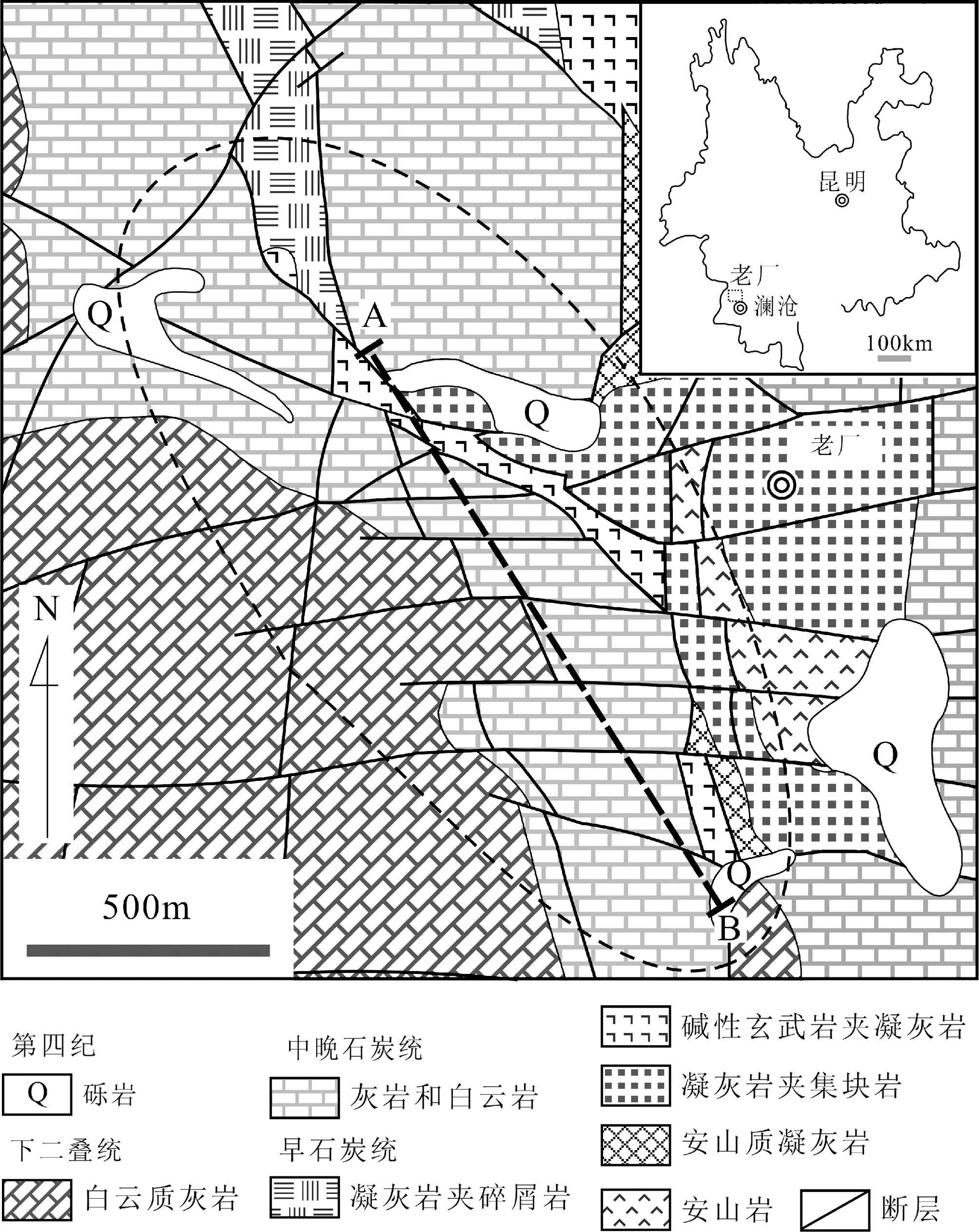
|
图 1 老厂铅锌多金属矿床矿区地质图(据龙汉生,2009修改) Fig. 1 Geological map of the Laochang Pb-Zn polymetallic deposit (after Long, 2009) |
矿床中铅锌多金属矿体多呈层状(上) 及网脉状(下) 产于中上石炭统(C2+3)-下二叠统(P1) 碳酸盐岩(碳酸岩型矿石) 和石炭系下统依柳组(C1y) 火山岩(火山岩型矿石) 中(图 2),由于前者基本被古人开采完,无法取样,因此,本研究以矿床中主体矿石类型-火山岩型铅锌矿石为主要研究对象,该类矿石成分复杂,金属矿物包括方铅矿、闪锌矿、黄铜矿、辉银矿、黄铁矿、褐铁矿等,脉石矿物为石英、方解石、白云石、长石、绢云母、电气石、石榴石等。其中闪锌矿多为黑色,呈他形充填于胶状黄铁矿间隙,并交代该类型黄铁矿(图 3a),常被他形黄铜矿交代(图 3b),因而常见其中黄铜矿“病毒”结构(图 3c),此外,少量闪锌矿呈他形星点状被立方体黄铁矿包裹交代(图 3d)。可见本矿床矿物生成顺序如下:胶状黄铁矿→早期方铅矿→闪锌矿→立方体黄铁矿→黄铜矿(砷黝铜矿)→晚期方铅矿。

|
图 2 老厂铅锌多金属矿床地质剖面图(据李雷等,1996修改) Fig. 2 Cross-section geological map through Laochang deposit (after Li et al., 1996) |
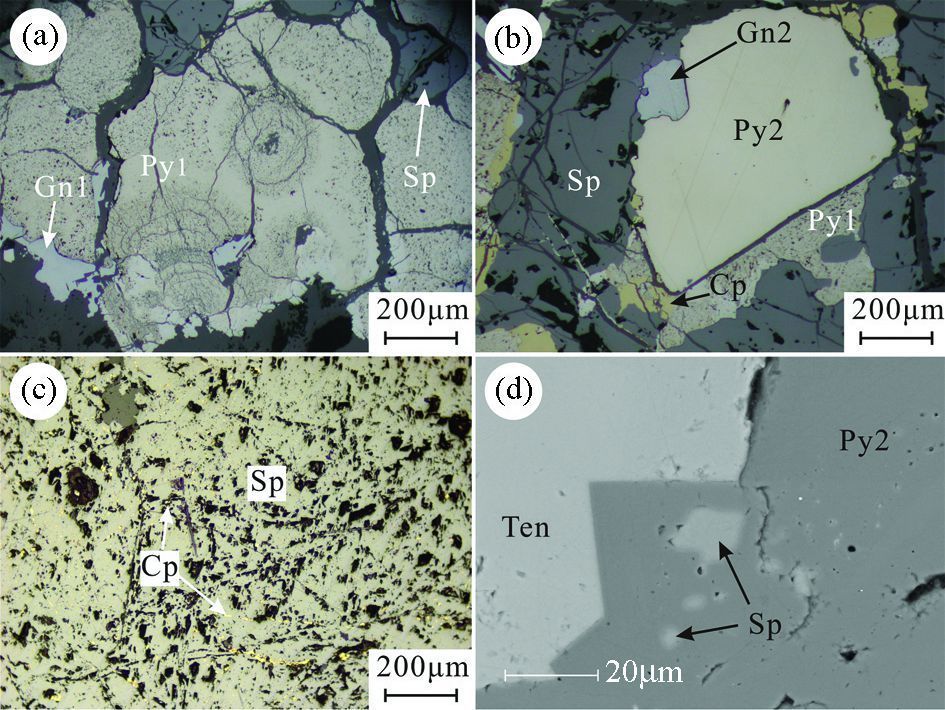
|
图 3 老厂铅锌多金属矿床铅锌矿石结构构造 (a)-他形闪锌矿(Sp) 充填于胶状黄铁矿(Py1) 间隙并交代方铅矿(Gn)(矿相照片); (b)-胶状黄铁矿被立方体晶形黄铁矿(Py2) 交代,闪锌矿包裹交代胶状黄铁矿并被黄铜矿(Cp) 交代,晚阶段方铅矿(Gn) 分布于交代边缘并交代闪锌矿与黄铜矿(矿相照片);(c)-闪锌矿中黄铜矿病毒结构(矿相照片);(d)-立方体黄铁矿(Py2) 与砷黝铜矿(Ten) 共生,他形闪锌矿被立方体黄铁矿包裹交代(SEM照片) Fig. 3 Textures and structures of Pb-Zn ores in Laochang polymetallic deposit (a)-xenomorphic sphalerite (Sp) fill in the interstice among colloform pyrites (Py1) and replace galena (Gn)(photomicrograph in reflected light); (b)-colloform pyrites (Py1) replaced by cubic pyrite (Py2), colloform pyrites (Py1) replaced by sphalerite which replaced by chalcopyrite (Cp), sphalerite and chalcopyrite replaced by late galena (Gn)(photomicrograph in reflected light); (c)-structure of chalcopyrit 'disease' in sphalerite (photomicrograph in reflected light); (d)-cubic pyrite coexist with tennantite (Ten), xenomorphic sphalerite replaced by cubic pyrite (SEM photomicrograph) |
矿床中闪锌矿以黑色为主,本研究分别采用LA-ICPMS和ICP-MS对其进行了相关微量元素分析,其中闪锌矿LA-ICPMS分析测试在澳大利亚塔斯马尼亚大学采用Agilent HP-7700 Quadripole ICPMS instrument at CODES (University of Tasmania, Hobart, Australia) 完成,测试所用束斑直径为50μm,共完成3个样品30个测点分析,测试元素包括: 49Ti、51V、53Cr、55Mn、57Fe、59Co、60Ni、65Cu、66Zn、69Ga、72Ge、75As、77Se、93Nb、95Mo、107Ag、111Cd、115In、118Sn、121Sb、125Te、182W、185Re、197Au、205Tl、208Pb、209Bi和238U,每个测点分析时间为90s,所用标样采用STDGL2b-2(该标样适合于不同类型硫化物定量分析测试,参见Danyushevsky et al., 2011)。分析结果通过以下分析结果校正因子校正:Mn 1.46、Fe 1.49、Co 1.51、Ni 1.59、Cu 1.53、Ga 1.45、As 1.36、Se 1.85、Mo1.62、Ag 1.40、Cd 1.50、In 1.45、Sn 1.6、Sb 1.17、Te 1.00、Au 1.40、Tl 2.17、Pb 1.37、Bi 1.33,所得结果分析误差<5%,详细分析流程参见Cook et al.(2009)。
对于ICP-MS测试样品,闪锌矿与方铅矿按常规溶样,在溶好样品中加入10mg Fe3+(20mg/mL FeHNO3溶液) 后,加入30% NaOH溶液中和至Fe3+黄色沉淀刚好出现,然后再加入5mL 30% NaOH溶液并加水到30mL,摇匀、离心,将上层清液倒掉并加水到30mL (重复3次),最后加入1mL HNO3溶解,加水至15mL待测(中国地质科学院国家地质实验测试中心测试)。黄铁矿与地层岩石的溶样流程及分析测试方法参见Qi et al.(2000),并在中国科学院地球化学研究所矿床地球化学国家重点实验室完成。ICP-MS分析过程中以国内标样GSR-5为标样,其分析精度优于5%。
3 分析结果分析结果如表 1和图 4所示,可以看出,LA-ICPMS与ICP-MS微量元素分析结果富集与亏损趋势相似,但ICP-MS测试微量元素变化范围明显较大,如其中Pb、Cu、Sn、Sb、Ag和Bi的变化范围分别是8548×10-6~147123×10-6、638×10-6~4852×10-6、7.89×10-6~185×10-6、7.78×10-6~313×10-6、8.19×10-6~522×10-6和0.38×10-6~1058×10-6,而LA-ICPMS所测试的变化范围分别为0.30×10-6~556×10-6、119×10-6~2020×10-6、2.23×10-6~38×10-6、0.001×10-6~4.10×10-6、4.80×10-6~10.1×10-6、0.001×10-6~0.05×10-6。此外,LA-ICPMS测试结果除Fe和Cd略高外,其余如Mn、Ga、Ge和In等元素均与ICP-MS分析结果类似。可见两种分析测试方法中部分元素分析结果存在差异,这可能与ICP-MS样品分选过程中不纯或其中混有显微包裹体矿物所致。
|
|
表 1 闪锌矿微量元素分析结果(×10-6) Table 1 Analytical result of trace elements for sphalerite (×10-6) |
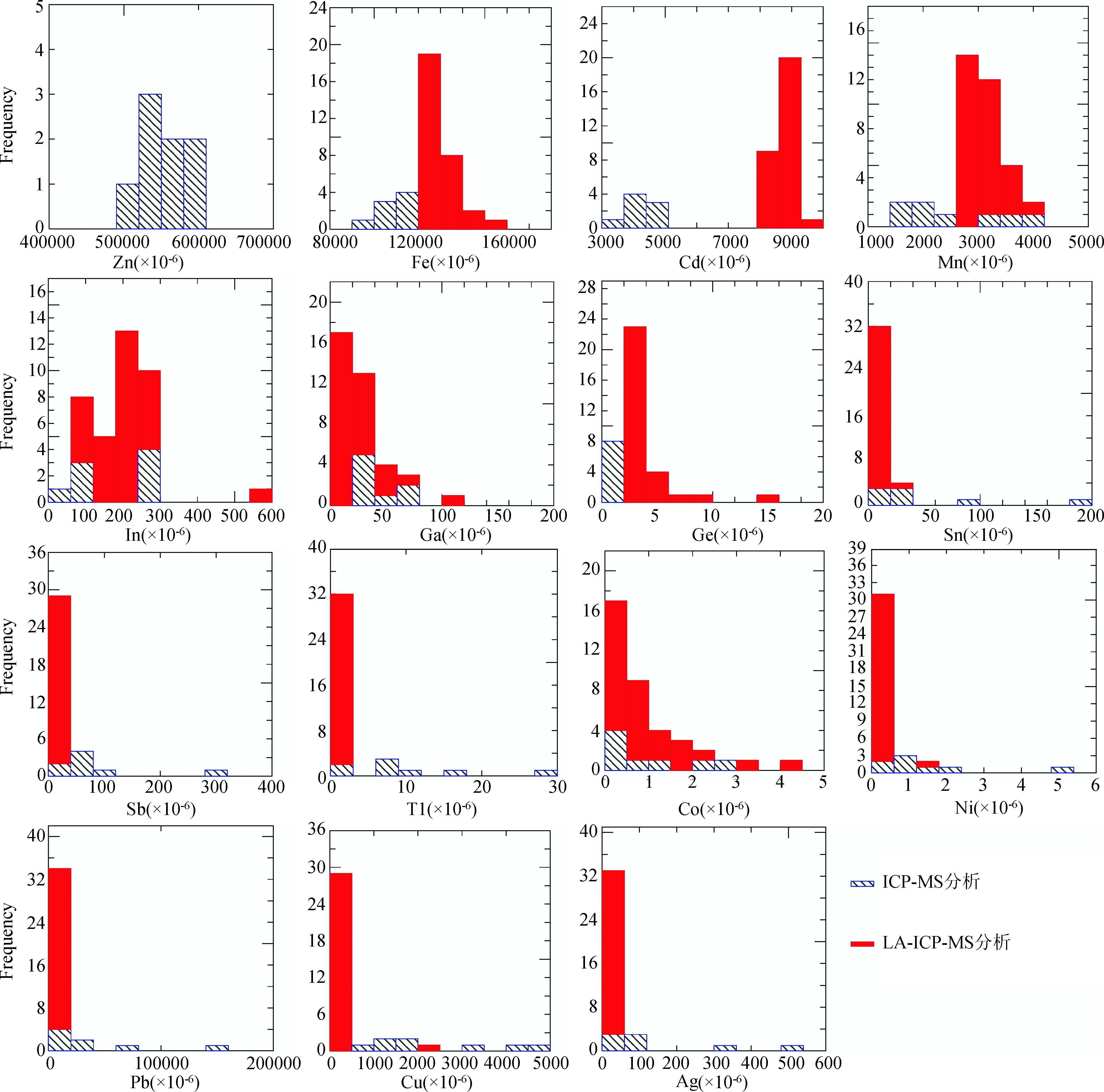
|
图 4 老厂闪锌矿微量元素含量直方图 Fig. 4 Histogram of trace elements for sphalerite |
总体而言,本矿床闪锌矿微量元素组成具有以下特征:
(1) 富集Fe,且变化范围狭窄,尽管两种测试方法存在差异,但不同方法测试结果均相对稳定,ICP-MS和LA-ICPMS测试结果分别为10.9±0.91%和13.1±0.78%,多数样品均大于10%,表明其属于Fe闪锌矿;
(2) Cd含量相对较高,其含量变化范围在3465×10-6~9600×10-6之间,平均为7776×10-6,其含量相对高于矽卡岩型铅锌矿床闪锌矿(如云南核桃坪与鲁子园),但明显低于MVT型铅锌矿床闪锌矿(如云南会泽、猛兴和贵州牛角塘),而与受晚期改造作用有关的喷流沉积铅锌矿床闪锌矿(如云南白牛厂和广东大宝山,Ye et al., 2011) 类似;
(3) 富In和Ga,局部富集Ge,其含量变化分别在58×10-6~566×10-6(均值196×10-6,n=38)、2.27×10-6~117×10-6(均值26×10-6,n=38) 和0.18×10-6~15.1×10-6(均值3.39×10-6,n=38) 之间,其In和Ga含量明显高于矽卡岩型矿床(如核桃坪与鲁子园),分别是其他VMS型矿床闪锌矿(如Zinkgruvan、Kaveltorp和Marketorp等,Cook et al., 2009) 的n~n×10和2~3倍,而与日本黑矿(Kuroko deposit,Nishiyama and Takashi, 1974) 和受晚期改造作用有关的喷流沉积铅锌矿床(如云南白牛厂和广东大宝山,Ye et al., 2011) 较相似;
(4) 富集Sn和Mn,其中Mn含量相对稳定,变化范围在1715×10-6~4152×10-6之间,平均值为2968×10-6(n=38),而Sn含量变化范围极大(2.23×10-6~185×10-6,平均为16×10-6,n=38);
(5) Pb、Cu含量变化大,本矿床闪锌矿中Pb和Cu含量分别在0.30×10-6~14.71×10-2(均值8670×10-6,n=38) 和119×10-6~4852×10-6(均值689×10-6,n=38) 之间。此外,ICP-MS分析结果显示其中Bi含量相对较高(0.38×10-6~1058 ×10-6,均值143×10-6,n=8),但LA-ICPMS测试结果显示其中Bi含量极低,多低于0.05×10-6,表明闪锌矿中可能存在Bi的显微包裹体矿物,如自然铋、辉铋矿等。
可见本矿床闪锌矿以富集Fe、Mn、Cd、In、Ga等元素为特征,其中Fe、Mn、Cd等元素含量相对较稳定,而In、Sn、Pb、Cu和Bi等元素含量变化范围较大。在LA-ICPMS时间分辨率剖面图中Fe、Mn、Cd、Ga和In等元素呈现平缓直线(图 5),表明这些元素以类质同象形式赋存于闪锌矿中,而Cu、Pb、Sn和Bi等元素则呈现变化幅度较大曲线(图 5),说明这些元素是以显微包裹体形式赋存于闪锌矿中,这与矿相及SEM分析所发现闪锌矿中存大量黄铜矿“病毒”结构及方铅矿及黝锡矿等矿物显微包裹体一致。此外,相关分析结果表明,闪锌矿中Cu与Sn (R=0.73,n=38)、Pb与Bi (R=0.85,n=38)、Pb与Ag (R=0.87,n=38) 有很好正相关关系,暗示Sn、Bi、Ag等元素局部富集可能与闪锌矿中显微包裹体黄铜矿、方铅矿等有关。

|
图 5 闪锌矿LA-ICPMS时间分辨率剖面图 (a)-样品Lc-19-1;(b)-样品Lc-18-3 Fig. 5 Representative time-resolved depth profiles for sphalerite analysed by LA-ICPMS (a)-sample Lc-19-1;(b)-sample Lc-18-3 |
闪锌矿中微量元素有规律的变化是成矿温度由高到低的客观反映,已有的研究表明,高温条件下形成闪锌矿富集Fe、Mn、In、Se、Te等元素,并以较高In/Ga比值为特征,而低温条件下形成闪锌矿则相对富集Cd、Ga、Ge等元素,以较低In/Ge比值为特征(刘英俊等,1984;韩照信,1994;蔡劲宏等,1996)。本矿床中的闪锌矿Fe含量多大于10%,相对富集Cd,且其中In含量较高,远高于低温闪锌矿,介于中温与高温闪锌矿之间,尽管个别闪锌矿Ga含量较高,但总体上均介于中温闪锌矿范围。表 1计算结果可知,矿床中闪锌矿In/Ga (0.88~99.65,平均17.92,n=38) 和In/Ge (11~1689,平均176,n=38) 比值相对较高,但明显低于高温热液矿床,如芙蓉锡矿田狗头岭矿区产出的闪锌矿(In/Ga为149.8~792.7,In/Ge为2091~16923,蔡劲宏等,1996),其Zn/Cd比值介于119~152之间,平均为133(n=8),与中温条件下形成闪锌矿Zn/Cd比值(100<Zn/Cd<500,刘英俊等,1984) 相似。此外,闪锌矿的微量元素Ga/Ge比值可与形成闪锌矿的溶液温度相对比(Peter, 1987),本矿床闪锌矿在logGaGe-T关系图(图略) 中投影点分布196~272℃之间,平均230℃(±22℃)。可见,本矿床成矿温度应以中温为主,这与前人包裹体测温结果(207~283℃,平均值为256℃,王增润等,1997) 相似,与喷流沉积成因的块状硫化物矿床的形成温度(250~350℃) 基本吻合。
4.2 成矿物质来源Y和Ho具有相同的价态和离子半径,八次配位,两者的离子半径分别为1.019×10-10和1.015×10-10,它们常具有相同的地球化学性质,在许多地质过程中,Y/Ho比值并不发生改变(Shannon, 1976),因此,可以利用Y和Ho对成矿流体及现代海底热液进行研究(Bau and Dulski, 1999;Douville et al., 1999;毛光周等,2006)。本矿床闪锌矿Y/Ho具有相对较宽变化范围,其比值在22.60~38.33之间(表 2、图 6),平均为29.74,与现代海底热液系统(BAB-弧后盆地;MAR-中大西洋洋脊;EPR-东太平洋洋脊) Y/Ho比值较相似,接近地层-早石炭统依柳组火山岩之安山质凝灰岩(24.16~29.28,平均26.36) 和碱性玄武岩(24.56~26.57,平均25.61) 变化范围,相对低于中晚石碳统碳酸岩(30.83~59.33,平均45.72) 和早二叠统灰岩(6.83~56.00,平均38.96),而与深部隐伏花岗斑岩极其狭窄Y/Ho变化范围(27.65~29.55,平均28.46) 明显不同,表明本矿床成矿物质(Pb、Zn等) 应主要来源于早石炭世火山岩(玄武岩及凝灰岩),在火山喷流作用下通过该地层及其基底物质的淋滤作用富集成矿,而与深部隐伏喜山期隐伏花岗斑岩关系不大。此外,喜山期隐伏花岗斑岩中Cu、W、Sn、Mo、Sb、Ga等元素富集程度较高,并形成巨厚Mo (Cu) 矿化,而其Pb、Zn含量低于或相当于世界花岗岩平均值(李雷等,1996),同样表明其并非为Pb和Zn潜在矿源层。
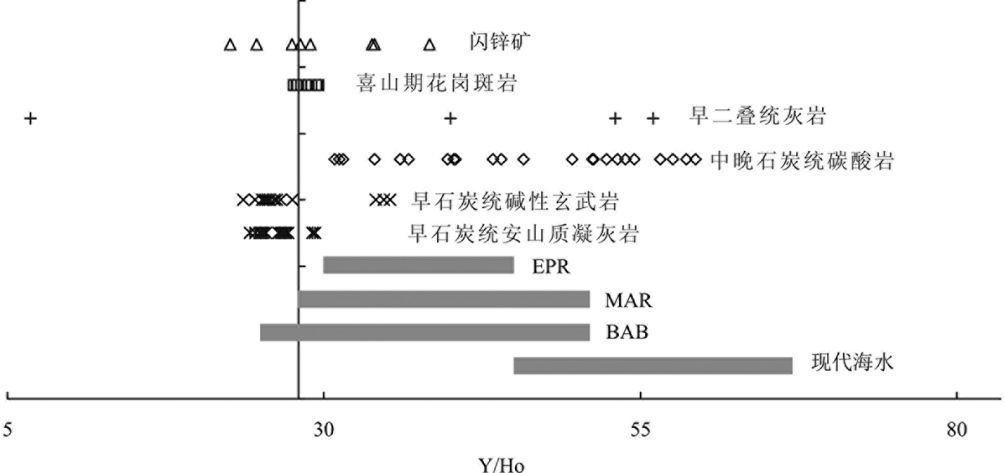
|
图 6 老厂矿区地层、岩体及硫化物与现代海底热液和海水的Y/Ho比值比较 BAB-弧后盆地;MAR-中大西洋洋脊;EPR-东太平洋洋脊(引自Bau et al., 1997; Bau and Dulski, 1999; Douville et al., 1999) Fig. 6 Y/Ho ratios of stratum, rock body and sulfides from Laochang ore area, modern submarine hydrothermal fluids and seawater BAB: back-arc basin; MAR: Middle-Atlantic Ridge; EPR: East Pacific Ridge (after Bau et al., 1997; Bau and Dulski, 1999; Douville et al., 1999) |
|
|
表 2 老厂矿区地层、岩体及闪锌矿Y/Ho比值对比表 Table 2 Contrast table of Y/Ho ratios of stratum, rock body and sulfides from Laochang ore area |
上述研究结果表明该矿床具有以下地质地球化学特征:
(1) 本矿床存在大量同生沉积结构构造,尽管其赋矿围岩类型与黑矿型矿床不同,但矿床位于拉张构造环境、成矿元素水平及垂向分带(上“黑矿”下“黄矿”,且上部以层状和块状矿石为主,而深部以网脉状矿化为主) 以及中等成矿温度等地质地球化学特征均与黑矿型矿床类似;
(2) 近矿围岩蚀变强烈,类型复杂,具多期叠加改造特点。矿石中分布大量Sb-、As-Pb和Cu-硫盐矿物(如碲硫砷铅矿-砷硫碲铅矿、车轮矿-硫砷铅铜矿、黝铜矿-砷黝铜矿系列,砷铜铅矿和细硫砷铅矿等),常包裹或与方铅矿共生,这类矿物组合与其结构构造与世界上加里东期VMS和SEDEX型矿床受改造作用矿床极其相似(如Sulitjelma, Bleikvassli, Norway;Cook, 1996;Cook et al., 1998)。此外,闪锌矿中大量黄铜矿“病毒”结构存在,也表明本矿床可能遭受了晚期富含Cu的流体改造。可见,本矿床后期热液叠加改造作用明显,闪锌矿中Cu与Sn极好的正相关关系,暗示改造流体富集Cu、Sn、Sb和As等成矿元素,可能与深部隐伏花岗斑岩的侵入作用有关。
(3) 矿床中闪锌矿以富Fe、Mn、Cd、In、Ga等元素为特征,其中Fe、Mn、Cd等元素含量相对较稳定,而In、Sn、Pb、Cu和Bi等元素含量变化范围较大。其中Fe和Mn等微量元素组成与一般VMS矿床类似,但In和Cd的异常富集可能暗示其独特的成矿机制,该特征明显不同与矽卡岩型矿床(如核桃坪与鲁子园,其闪锌矿以富Co、相对富集Fe和贫In、Ga、Sn为特征,Ye et al., 2011),而与燕山-喜山期花岗岩叠加改造作用有关的喷流沉积铅锌矿床(如云南白牛厂和广东大宝山) 类似,该类型矿床与老厂矿床矿石具相似的结构构造,其闪锌矿均以富集Fe、In、Ga和Sn为主要特征(Ye et al., 2011)。在Ga+Ge-Se+Te +In-Ag三角图解(图 7) 中,本矿床闪锌矿投影点分布于Se+Te+In端员,而与长江中下游岩浆热液型矿床中闪锌矿差异明显,表明铅锌成矿作用应与矿区喜山期花岗斑岩无关。而在In-Fe、In-Sn、Cu+Ag-In+Sn和Cd/Fe-In/Fe关系图(图 8) 及In-Ge、In-Co、Cu-Sn、Fe-Mn、Fe-Cd、Ga-Ge、Fe-Ge和Cd/Fe-Co/Ni等关系图解(图略) 中,老厂闪锌矿投影点均与受晚期热液叠加改造作用有关的喷硫沉积铅锌矿床(如云南白牛厂和广东大宝山) 分布于相同区域,而明显不同于矽卡岩型矿床(如核桃坪与鲁子园),更不同于MVT型铅锌矿床(牛角塘、会泽和勐兴,该类型矿床闪锌矿以富Cd贫In和Fe为特征) 和金顶铅锌矿床(其闪锌矿微量元素组成与MVT型矿床相似,但Ge和Tl富集程度相对较高)。可见,本矿床闪锌矿微量元素组成具喷流沉积成因闪锌矿特征,同时,后期叠加改造作用可能使其微量元素组成(如Sn等) 发生一定程度变化。
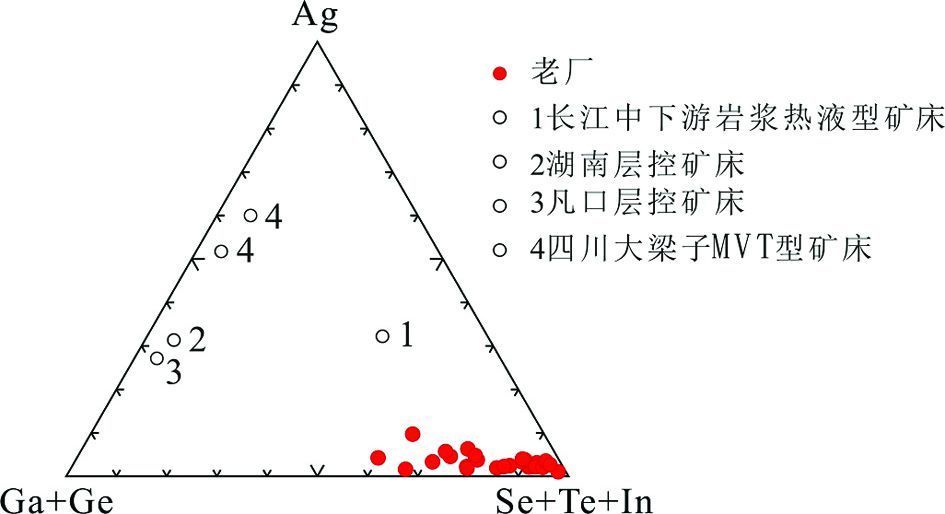
|
图 7 闪锌矿Ga+Ge-Se+Te+In-Ag三角图解(底图据朱赖民等,1995) Fig. 7 Triangular diagram of Ga+Ge-Se+Te+In-Ag for sphalerite (after Zhu et al., 1995) |

|
图 8 老厂及国内其它铅锌矿床闪锌矿In-Fe、In-Sn、(Cu+Ag)-(In+Sn) 和Cd/Fe-In/Fe关系图(LA-ICPMS分析结果,其它铅锌矿床闪锌矿数据源自Ye et al., 2011) Fig. 8 Binary plots of In vs. Fe, In vs. Sn, (Cu+Ag) vs.(In+Sn), Cd/Fe vs. In/Fe in sphalerite from Laochang and other Pb-Zn deposits in China (plotted based on LA-ICPMS data, the data of other deposits after Ye et al., 2011) |
此外,本矿床黄铁矿及方铅矿微量元素组成研究结果表明其成因复杂,既有火山喷流沉积成因,也有晚期岩浆热液叠加改造成因(高伟,2011)。因此,综合本矿床产出地质特征,结合闪锌矿等硫化物单矿物微量元素组成特征,笔者认为老厂铅锌多金属矿床中铅锌矿化作用应与喷流沉积作用有关,但喜山期花岗斑岩侵入带来了丰富的Cu和Sn等成矿物质,并对早期形成的铅锌矿体进行了强烈叠加改造,致使矿体、硫化物及其相关地层不同程度富集Sn等元素,这与Pb、H、O等同位素研究认为成矿流体具有多期、多阶段、多来源等特征(徐楚明和欧阳成甫,1991;叶庆同等,1992;龙汉生,2009) 相吻合。
5 结论综上所述,我们可以得到以下认识:
(1) 硫化物单矿物微量元素分析中,LA-ICPMS相对于ICP-MS分析具有更高精度,不仅可以进行硫化物原位分析,并能即时了解微量元素在硫化物中赋存状态,而且克服了ICP-MS分析中单矿物选样不纯等弱点;
(2) 云南澜沧老厂铅锌多金属矿床中闪锌矿属于铁闪锌矿,形成于中温环境,以富Fe、Mn、Cd和In等元素为特征,其中Fe、Mn、Cd、In等元素以类质同象形式赋存于闪锌矿中,而Sn、Pb、Cu和Bi等元素含量变化范围较大,局部富集,以显微包裹体赋存于闪锌矿中。本矿床闪锌矿中Fe和Mn等微量元素组成与一般VMS矿床类似,但In和Cd的异常富集可能暗示其独特的成矿机制。总体上闪锌矿中微量元素组成特征和与燕山-喜山期花岗岩叠加改造作用有关的喷流沉积铅锌矿床(如云南白牛厂和广东大宝山) 相似,而明显不同与矽卡岩型矿床(如核桃坪与鲁子园),更不同于MVT型铅锌矿床(如牛角塘、会泽和勐兴) 和金顶铅锌矿床。
可见,云南澜沧老厂铅锌多金属矿区经历了古、中、新特提斯期不同程度的拉张与闭合发展演化,使矿床多期同位叠加成矿特征明显,其闪锌矿微量元素组成具喷流沉积成因特征,深部喜山期花岗斑岩与铅锌成矿作用关系不大,但在其侵入过程中叠加改造作用使闪锌矿等硫化物组合及其微量元素组成发生一定程度变化(如局部富集Sn和Sb等元素),并形成大量黄铜矿“病毒”结构等。
致谢 分析测试过程中得到澳大利亚Adelaide大学Nigel J. Cook教授和Cristiana L. Ciobanu博士的指导;野外采样过程中得到云南澜沧老厂铅锌矿石增龙总工等地质科研人员的帮助;在此一并致谢!| [] | Bau M, Möller P and Dulski P. 1997. Yttrium and lanthanides in eastern Mediterranean seawater and their fractionation during redox-cycling. Mar. Chem., 56: 123–131. DOI:10.1016/S0304-4203(96)00091-6 |
| [] | Bau M and Dulski P. 1999. Comparing yttrium and rare earths in hydrothermal fluids from the Mid-Atlantic Ridge: Implications for Y and REE behavior during near-vent mixing and for the Y/Ho ratio of Proterozoic seswater. Chem. Geol., 155: 77–90. DOI:10.1016/S0009-2541(98)00142-9 |
| [] | Beaudoin G. 2000. Acicular sphalerite enriched in Ag, Sb, and Cu embedded within colour banded sphalerite from the Kokanee Range, BC. Canadian Mineralogist, 38: 1387–1398. DOI:10.2113/gscanmin.38.6.1387 |
| [] | Cai JH, Zhou WN and Zhang JZ. 1996. Typomorphic characteristics of sphalerites in the Yinshan copper, lead and zinc polymetallic deposit, Jiangxi. Journal of Guilin Institute of Technology, 16(4): 370–375. |
| [] | Chen BY, Wang ZR, Peng SL, Zhang YX and Chen W. 2000. A discussion about the genesisof Laochang polymetallic deposit, Yunnan. Yunnan Geology, 21(2): 134–144. |
| [] | Chen BY. 2002. Study on metallogeny of the Laochang Ag-Pb-Zn-Cu polymetallic ore deposit of Lancang, Yunnan. Ph. D. Dissertation. Changsha: Central-South University, 1-123 (in Chinese with English sumary) |
| [] | Chen M. 2010. Geochronology and geochemistry of the basalt from Laochang lrge Ag-Pb-Zn polymetallic deposit, Yunnan Province, China. Ph. D. Dissertation. Guiyang: Institute of Geochemistry, Chinese Academy of Sciences, 1-133(in Chinese with English summary) |
| [] | Chen SL, Pen SL and Wang ZR. 1997. Structural characteristics of Laochang Ag-Pb orefield in Lanchang, Yunnan. Chinese Journal of Nonferrous Metals, 7(3): 1–5. |
| [] | Chen YY. 1995. Geological characteristics and genesis of Laochang volcanic-hosted silver, lead, zinc and copper deposit in Yunnan. Journal of Guilin Institute of Technology, 15(2): 124–130. |
| [] | Cook NJ. 1996. Mineralogy of the sulphide deposits at Sulitjelma, northern Norway. Ore Geology Reviews, 11: 303–308. DOI:10.1016/S0169-1368(96)00009-1 |
| [] | Cook NJ, Spry PG and Vokes FM. 1998. Mineralogy, paragenesis and metamorphism of ores in the Bleikvassli Pb-Zn-(Cu) deposit, Nordland, Norway. Mineralium Deposita, 34: 35–56. DOI:10.1007/s001260050184 |
| [] | Cook NJ, Ciobanu CL, Pring A, Skinner W, Danyushevsky L, Shimizu M, Saini-Eidukat B and Melcher F. 2009. Trace and minor elements in sphalerite: A LA-ICP-MS study. Geochimica et Cosmochimica Acta, 73: 4761–4791. DOI:10.1016/j.gca.2009.05.045 |
| [] | Cook NJ, Ciobanu CL and Williams T. 2011a. The mineralogy and mineral chemistry of indium in sulphide deposits and implications for mineral processing. Hydrometallurgy, 108(3-4): 226–228. DOI:10.1016/j.hydromet.2011.04.003 |
| [] | Cook NJ, Sundblad K, Valkama M, Nygård R, Ciobanu CL and Danyushevsky L. 2011b. Indium mineralisation in A-type granites in southeastern Finland: Insights into mineralogy and partitioning between coexisting minerals. Chemical Geology, 284: 62–73. DOI:10.1016/j.chemgeo.2011.02.006 |
| [] | Danyushevsky LV, Robinson P, Gilbert S, Norman M, Large R, McGoldrick P and Shelley JMG. 2011. Routine quantitative multi-element analysis of sulphide minerals by laser ablation ICP-MS: Standard development and consideration of matrix effects. Geochemistry: Exploration, Environment, Analysis, 11: 51–60. DOI:10.1144/1467-7873/09-244 |
| [] | Di Benedetto F, Bernardini GP, Costagliola P, Plant D and Vaughan DJ. 2005. Compositional zoning in sphalerite crystals. American Mineralogist, 90: 1384–1392. DOI:10.2138/am.2005.1754 |
| [] | Ding L and Zhong DL. 1995. The character of REE and Ce anomaly for siliceous rocks of the Paleo Tethys Ocean in Changning-Menglian belt. Science in China (Series B), 25(1): 93–100. |
| [] | Douville E, Bienvenu P and Charlou JI. 1999. Yttrium and rare earth elements in fluids from various deep-sea hydrothermal systems. Geochim. Cosmochim. Acta, 63: 627–643. DOI:10.1016/S0016-7037(99)00024-1 |
| [] | Feng QL and Liu BP. 1993. Stratigraphic investigation of volcanic rocks in Changning-Menglian tectonic belt, southwestern Yunnan, China. Geoscience, 7(4): 402–409. |
| [] | Gottesmann W and Kampe A. 2007. Zn/Cd ratios in calcsilicate-hosted sphalerite ores at Tumurtijn-ovoo, Mongolia. Chemie der Erde, 67: 323–328. DOI:10.1016/j.chemer.2007.01.002 |
| [] | Gao W. 2011. The studying on the geochemistry of the Laochang lead-zinc polymetallic deposit in Lancang. Master Degree Thesis. Guiyang: Institute of Geochemistry, Chinese Academy of Sciences, 1-107 (in Chinese with English summary) |
| [] | Han ZX. 1994. The typomorphic characteristic of the sphalerite in the Qinling Devonian System lead-zinc metallogenic belt. Journal of Xi'an Engineering University, 16(1): 12–17. |
| [] | Hou ZQ, Zaw K, Pan GT, Mo XX, Xu Q, Hu YZ and Li XZ. 2007. Sanjiang Tethyan metallogenesis in S. W. China: Tectonic setting, metallogenic epochs and deposit types. Ore Geology Reviews, 31: 48–87. |
| [] | Huston DL, Sie SH, Suter GF, Cooke DR and Both RA. 1995. Trace elements in sulfide minerals from eastern Australian volcanic-hosted massive sulfide deposits; Part I, Proton microprobe analyses of pyrite, chalcopyrite, and sphalerite, and Part II, Selenium levels in pyrite; comparison with δ34S values and implications for the source of sulfur in volcanogenic hydrothermal systems. Economic Geology, 90: 1167–1196. DOI:10.2113/gsecongeo.90.5.1167 |
| [] | Ishihara S, Hoshino K, Murakami H and Endo Y. 2006. Resource evaluation and some genetic aspects of indium in the Japanese ore deposits. Resource Geology, 56: 347–364. DOI:10.1111/rge.2006.56.issue-3 |
| [] | Ishihara S and Endo Y. 2007. Indium and other trace elements in volcanogenic massive sulphide ores from the Kuroko, Besshi and other types in Japan. Bulletin, Geological Survey of Japan, 58: 7–22. DOI:10.9795/bullgsj.58.7 |
| [] | Li F, Lu WJ, Yang YZ, Chen H, Luo SL and Shi ZL. 2009. The rock-and ore-forming ages of the Laochang porphyry molybdenum deposit in Lancang, Yunnan. Geoscience, 23(6): 1049–1055. |
| [] | Li F, Chen H, Lu WJ and Luo SL. 2010. Rock-forming ages of the Laochang granite-porphyry, Lancang, Yunnan and their geological significance. Geotectonica et Metallogenia, 34(1): 84–91. |
| [] | Li GD. 2010. Geological characteristics, ore-controlling factors of the Laochang Ag-Pb-Zn-Cu deposit in Lancang, Yunnan and its prospecting targets. Mineral Resources and Geology, 24(1): 59–63. |
| [] | Li HJ. 1990. Geologic characteristics and genesis of the Pb-Zn-Ag polymetallic sulfides deposit in Lancang, Yunnan. Journal of Sichuan Institute of Building Materials, 5(4): 65–73. |
| [] | Li HJ, Tian X and Yi FC. 1995. The stable isotope geochemistry of the Lancang Pb-Ag-Zn-Cu deposit in Yunnan Province. Geological Exploration for Non-Ferrous Metals, 4(5): 278–282. |
| [] | Li L, Duan JR, Li F, Ma Y and Huang DY. 1996. Geologic features and multiperiodic syntopogenic metallogenesis of the Laochang Cu-polymetal deposit in Lancang, Yunnan. Yunnan Geology, 15(3): 246–256. |
| [] | Li XY, Wang XL, Li W, Liu DR and Chen CF. 2007. Geological features of the Laochang Ag-Cu-Pb-Zn deposit in Lancang, Yunnan. Journal of Sichuan Geology, 27(1): 25–30. |
| [] | Liu YJ, Cao LM and Li ZL. 1984. Element Geochemistry. Beijing: Geological Publishing House: 1-548. |
| [] | Liu YM and Yang WH. 2001. Geochemical characteristics of volcanic rock of the Laochang Ag polymetallic deposit, Lancang, Yunnan. Acta Mineralogica Sinica, 21(4): 699–704. |
| [] | Long HS, Jiang SP, Shi ZL, Huang ZL and Luo TY. 2007. Carbon and oxygen isotopic geochemistry of Laochang large-sized Ag polymetallic deposit in Lancang, Yunnan Province and its significance. Acta Mineralogica Sinica, 27(3-4): 360–365. |
| [] | Long HS. 2009. Geochronology and geochemistry of the Laochang large silver polymetallica deposit, Yunnan Province, China. Ph. D. Dissertation. Guiyang: Institute of Geochemistry, Chinese Academy of Sciences, 1-168(in Chinese with English summary) |
| [] | Mao GZ, Hua RM, Gao JF, Zhao KD, Long GM, Lu HJ and Yao JM. 2006. REE composition and trace element features of gold-bearing pyrite in Jinshan gold deposit, Jiangxi Province. Mineral Deposits, 25(4): 412–426. |
| [] | Martín JD and Gil ASI. 2005. An integrated thermodynamic mixing model for sphalerite geobarometry from 300 to 850℃ and up to 1GPa. Geochim. Cosmochim. Acta, 69: 995–1006. DOI:10.1016/j.gca.2004.08.009 |
| [] | Mo XX, Lu FX, Shen SY, et al. 1993. Sanjiang Tethyan Volcanism and Related Mineralization. Beijing: Geological Publishing House: 1-267. |
| [] | Monteiro LVS, Bettencourt JS, Juliani C and Oliveira TF. 2006. Geology, petrography, and mineral chemistry of the Vazante non-sulfide and Ambro' sia and Fagundes sulfide-rich carbonate-hosted Zn-(Pb) deposits, Minas Gerais, Brazil. Ore Geol. Rev., 28: 201–234. DOI:10.1016/j.oregeorev.2005.03.005 |
| [] | Nishiyama and Takashi.1974. Minor elements in some sulfide minerals from the Kuroko deposits of the Shakanai mine. In: Ishihara S (ed.). Geology of Kuroko Deposits. Mining Geology Special Issue, 6: 371-376 |
| [] | Ouyang CF and Xu CM. 1993. Predicted existence of a concealed granitic body in the Laochang silver-lead deposit and the geologic significance, Lancang, Yunnan. Geotectonica et Metallogenia, 17(2): 119–126. |
| [] | Pen SZ. 1984. The discussion on the metallogenic geological conditions of Ag-Pb-Zn metallogenic belt. Yunnan Geology, 3(2): 124–130. |
| [] | Peter M. 1987. Correlation of homogenization temperatures of accessory minerals from sphalerite-bearing deposits and Ga/Ge model temperatures. Chemical Geology, 61: 153–159. DOI:10.1016/0009-2541(87)90035-0 |
| [] | Qi L, Hu J and Gregoire DC. 2000. Determination of trace elements in granites by inductively coupled plasma mass spectrometry. Talanta, 51(3): 507–513. DOI:10.1016/S0039-9140(99)00318-5 |
| [] | Shannon RD. 1976. Revised effective ionic radii and systematic studies of interatomic distances in halides and chalcogenides. Acta Cryst, A32: 751–767. |
| [] | Tu GC, Gao ZM and Hu RZ. 2003. Geochemistry and Mineralization Mechanism of Dispersed Elements. Beijing: Geological Publishing House: 1-424. |
| [] | Wang CM, Deng J, Zhang ST, Xue CJ, Yang LQ, Wang QF and Sun X. 2010. Sediment-hosted Pb-Zn deposits in Southwest Sanjiang Tethys and Kangdian area on the western margin of Yangtze Craton. Acta Geologica Sinica, 84(6): 1428–1438. DOI:10.1111/acgs.2010.84.issue-6 |
| [] | Wang DH, Yang JM, Yan SH, Xu J, Chen YC, Xue CJ, Luo YN and Yin HL. 2002. Cenozoic ore concentration areas in the Sanjiang Region, SW China: Tectonic setting and exploration. Acta Geoscienctia Sinica, 23(2): 135–140. |
| [] | Wang XL, Pang YC, Huang ML, Sun LX and Li W. 2006. Geology and genesis of Laochang Ag-Cu-Pb-Zn polymetallic ore deposit in Lancang, Yunnan Province. Geology and Resources, 15(3): 200–204. |
| [] | Wang ZR, Huang Z, Peng SL, Chen SL and Hu XZ. 1997. Genesis and metallogenic model of Laochang-type silver multimetal massive sulfide deposits in Lancang, Yunan Province. Chinese Journal of Nonferrous Metals, 7(4): 1–6. |
| [] | Wei GJ. 2005. The optimization of prospecting targets by mineralization information of remote sensing geology in Laochang deposit, Lancang. Master Degree Thesis. Kunming: Kunming University of Science and Technology (in Chinese with English summary) |
| [] | Xu CM and Ouyang CP. 1991. A study on the genesis of the Ag-Pb-Zn deposit in Laochang, Lancang, Yunnan. Journal of Guilin Metallurgical and Geological Institute, 11(3): 245–252. |
| [] | Xue BG. 1998. mineralization characteristics of the Laochang Ag-Pb polymetallic deposit, Lancang. Mineral Resources and Geology, 12(1): 26–32. |
| [] | Yang KH, Hou ZQ and Mo XX. 1992. Volcanogenic massive sulfide deposits in sanjiang region, Southwest China: Geological features and main types. Mineral Deposits, 11(1): 35–44. |
| [] | Yang KH and Mo XX. 1993a. Main features and genetical type of the Laochang volcanogenic massive sulfide deposit, Yunnan Province. Journal of Institute of Chinese Academy of Geological Sciences, 26: 79–96. |
| [] | Yang KH and Mo XX. 1993b. Late Paleozoic rifting-related volcanic rocks and tectonic evolution in southwestern Yunnan. Acta Petrologica et Mineralogica, 12(4): 297–311. |
| [] | Ye QT, Hu YZ and Yang YQ. 1992. Regional Geochemical Background and Gold, Silver and Lead-zinc Mineralization in the Nujiang-Lancangjiang-Jinshajiang Area. Beijing: Geological Publishing House: 1-279. |
| [] | Ye L, Cook NJ, Ciobanu CL, Liu YP, Zhang Q, Liu TG, Gao W, Yang YL and Danyushevskiy L. 2011. Trace and minor elements in sphalerite from base metal deposits in South China: A LA-ICPMS study. Ore Geology Review, 39: 188–217. DOI:10.1016/j.oregeorev.2011.03.001 |
| [] | Zhang Q. 1987. Trace elements in galena and sphalerite and their geochemical significance in distinguishing the genetic types of Pb-Zn ore deposits. Chinese Journal of Geochemistry, 6: 177–190. DOI:10.1007/BF02872218 |
| [] | Zhang Z, Li B, Chen CH and Yang JZ. 2006. Research on primary minerals geological characteristics and cause in old Lancang Factory's silver-lead deposits. West-China Exploration Engineering, 18(12): 125–128. |
| [] | Zhou YH, Wang XL, Pang YC, Huang ML, Fu XG and Ma YQ. 2007. A discussion on the carboniferous stratigraphic division and the age assignment of the former "C2+3"carbonate rock in Laochang mining aera, Lancang, Yunnan, China. Journal of Chengdu Unversity of Technology (Science & Technology Edition), 34(2): 210–215. |
| [] | Zhu LM, Yuan HH and Luan SW. 1995. Typomorphic characteristics and their significance of minor elements of sphalerite from Disu and Daliangzi Pb-Zn deposits, Sichuan. Acta Geologica Sichuan, 15(1): 49–55. |
| [] | 蔡劲宏, 周卫宁, 张锦章. 1996. 江西银山铜铅锌多金属矿床闪锌矿的标型特征. 桂林工学院学报, 16(4): 370–375. |
| [] | 陈百友, 王增润, 彭省临, 张映旭, 陈伟. 2000. 澜沧老厂银铅锌铜多金属矿床成因探讨. 云南地质, 21(2): 134–144. |
| [] | 陈百友.2002.云南省澜沧老厂银铅锌铜多金属矿床成矿学研究.博士学位论文.长沙:中南大学, 1-123 |
| [] | 陈觅. 2010.云南澜沧老厂银铅锌多金属矿床玄武岩年代学和地球化学.博士学位论文.贵阳:中国科学院地球化学研究所, 1-133 |
| [] | 陈松岭, 彭省临, 王增润. 1997. 澜沧老厂银铅矿矿田构造. 中国有色金属学报, 7(3): 1–5. |
| [] | 陈元琰. 1995. 云南老厂火山岩型银铅锌铜矿床地质特征及成因. 桂林工学院学报, 15(2): 124–130. |
| [] | 丁林, 钟大赉. 1995. 滇西昌宁-孟连带古特提斯洋硅质岩稀土元素和铈异常特征. 中国科学(B辑), 25(1): 93–100. |
| [] | 冯庆来, 刘本培. 1993. 滇西南昌宁-孟连构造带火山岩地层学研究. 现代地质, 7(4): 402–409. |
| [] | 高伟.2011.滇西澜沧老厂铅锌多金属矿床地球化学研究.硕士学位论文.贵阳:中国科学院地球化学研究所, 1-107 |
| [] | 韩照信. 1994. 秦岭泥盆系铅锌成矿带中闪锌矿的标型特征. 西安地质学院学报, 16(1): 12–17. |
| [] | 李峰, 鲁文举, 杨映忠, 陈珲, 罗思亮, 石增龙. 2009. 云南省澜沧老厂斑岩钼矿成岩成矿时代研究. 现代地质, 23(6): 1049–1055. |
| [] | 李峰, 陈珲, 鲁文举, 罗思亮. 2010. 云南澜沧老厂花岗斑岩形成年龄及地质意义. 大地构造与成矿学, 34(1): 84–91. |
| [] | 李光斗. 2010. 云南澜沧老厂银铅锌铜矿床地质特征、控矿要素及找矿靶区. 矿产与地质, 24(1): 59–63. |
| [] | 李虎杰. 1990. 云南澜沧铅锌银多金属硫化物矿床地质特征及成因. 四川建材学院学报, 5(4): 65–73. |
| [] | 李虎杰, 田煦, 易成发. 1995. 云南澜沧铅锌银铜矿床稳定同位素地球化学研究. 有色金属矿产与勘查, 4(5): 278–282. |
| [] | 李雷, 段嘉瑞, 李峰, 马远, 黄敦义. 1996. 澜沧老厂铜多金属矿床地质特征及多期同位成矿. 云南地质, 15(3): 246–256. |
| [] | 李潇雨, 王新利, 李威, 刘道荣, 陈春发. 2007. 云南澜沧老厂银铜铅锌矿床地质特征及成因研究. 四川地质学报, 27(1): 25–30. |
| [] | 刘友梅, 杨蔚华. 2001. 澜沧老厂银多金属矿床火山岩地球化学特征及环境识别. 矿物学报, 21(4): 699–704. |
| [] | 刘英俊, 曹励明, 李兆麟. 1984. 元素地球化学. 北京: 地质出版社: 1-548. |
| [] | 龙汉生, 蒋少平, 石增龙, 黄智龙, 罗泰义. 2007. 云南澜沧老厂大型银铅锌多金属矿床地质地球化学特征. 矿物学报, 27(3-4): 360–365. |
| [] | 龙汉生. 2009.云南澜沧老厂大型银多金属矿床成矿年代及地球化学.博士学位论文.贵阳:中国科学院地球化学研究所, 1-168 |
| [] | 毛光周, 华仁民, 高剑峰, 赵葵东, 龙光明, 陆慧娟, 姚军明. 2006. 江西金山金矿床含金黄铁矿的稀土元素和微量元素特征. 矿床地质, 25(4): 412–426. |
| [] | 莫宣学, 路凤香, 沈上越, 等. 1993. 三江特提斯火山作用与成矿. 北京: 地质出版社: 1-267. |
| [] | 欧阳成甫, 徐楚明. 1993. 云南澜沧老厂银铅矿区隐伏花岗岩体预测及其意义. 大地构造与成矿学, 17(2): 119–126. |
| [] | 彭寿增. 1984. 试论澜沧含银铅锌矿带的成矿地质条件. 云南地质, 3(2): 124–130. |
| [] | 涂光炽, 高振敏, 胡瑞忠. 2003. 分散元素地球化学及成矿机制. 北京: 地质出版社: 1-424. |
| [] | 王登红, 杨建民, 闫升好, 徐珏, 陈毓川, 薛春纪, 骆耀南, 应汉龙. 2002. 西南三江新生代矿集区的分布格局及找矿前景. 地球学报, 23(2): 135–140. |
| [] | 王新利, 庞艳春, 黄霂莲, 孙利勋, 李威. 2006. 澜沧老厂银铜铅锌多金属矿床地质特征及成因探讨. 地质与资源, 15(3): 200–204. |
| [] | 王增润, 黄震, 彭省临, 陈松岭, 胡祥昭. 1997. 澜沧"老厂型"银多金属块状硫化物矿床成因和成矿模式. 中国有色金属学报, 7(4): 1–6. |
| [] | 魏冠军. 2005.澜沧老厂矿床遥感地质成矿信息融合的靶区优选.硕士学位论文.昆明:昆明理工大学 |
| [] | 徐楚明, 欧阳成甫. 1991. 云南澜沧老厂银铅锌矿床成因研究. 桂林冶金地质学院学报, 11(3): 245–252. |
| [] | 薛步高. 1998. 论澜沧老厂银铅多金属矿床成矿特征. 矿产与地质, 12(1): 26–32. |
| [] | 杨开辉, 侯增谦, 莫宣学. 1992. "三江"地区火山成因块状硫化物矿床的基本特征与主要类型. 矿床地质, 11(1): 35–44. |
| [] | 杨开辉, 莫宣学. 1993a. 云南澜沧老厂火山成因块状铅锌铜硫化物矿床的基本特征及其成因类型. 中国地质科学院院报, 26: 79–96. |
| [] | 杨开辉, 莫宣学. 1993b. 滇西南晚古生代火山岩与裂谷作用及区域构造演化. 岩石矿物学杂志, 12(4): 297–311. |
| [] | 叶庆同, 胡云中, 杨岳清. 1992. 三江地区区域地球化学背景和金银铅锌成矿作用. 北京: 地质出版社: 1-279. |
| [] | 张准, 李波, 陈春华, 杨吉忠. 2006. 澜沧老厂银铅矿床原生矿体地质特征及成因研究. 西部探矿工程, 18(12): 125–128. |
| [] | 周玉华, 王新利, 庞艳春, 黄霂莲, 付修根, 马叶青. 2007. 云南澜沧老厂矿区石炭系划分及原中上石炭统碳酸盐岩时代归属探讨. 成都理工大学学报(自然科学版), 34(2): 210–215. |
| [] | 朱赖民, 袁海华, 栾世伟. 1995. 金阳底苏会东大梁子铅锌矿床内闪锌矿微量元素标型特征及其研究意义. 四川地质学报, 15(1): 49–55. |
 2012, Vol. 28
2012, Vol. 28

